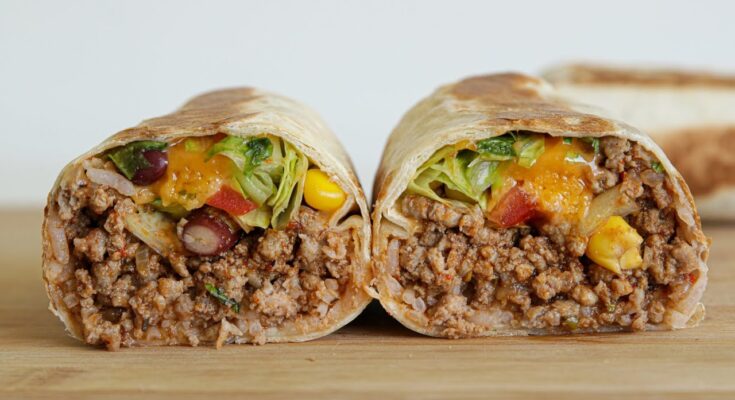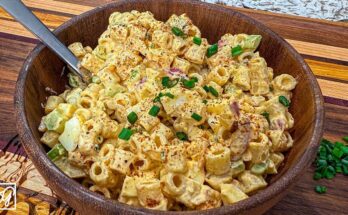Bean Burrito Recipe: Bean burritos are the unsung heroes of comfort food. They strike a perfect balance between taste, health, and convenience, making them a go-to meal for busy weeknights, laid-back weekends, or even on-the-go lunches. Their simplicity is their superpower. Just think about it—hearty beans wrapped in a warm tortilla, bursting with flavor from spices, vegetables, and perhaps a sprinkle of cheese or a dollop of sour cream. What’s not to love?
Beyond being delicious, bean burritos are incredibly versatile. Whether you’re a meat lover, a vegetarian, or somewhere in between, you can customize them to your taste. They’re budget-friendly, too, using basic pantry staples like beans, rice, tortillas, and some veggies. And let’s not forget they’re satisfying and filling without being heavy on your stomach.
People love them not just because they’re easy to make, but because they deliver on all fronts—nutrition, comfort, and crave-worthy flavor. In fact, if you’re trying to eat healthier without sacrificing your love for flavorful food, bean burritos are a total win.
Nutritional Benefits of Bean Burritos
Don’t be fooled by the term “burrito” into thinking it’s a junk food indulgence. Bean burritos, when made with wholesome ingredients, pack a serious nutritional punch. For starters, beans are rich in plant-based protein and fiber, which are essential for maintaining energy levels, improving digestion, and keeping you full longer.
Black beans, pinto beans, or kidney beans—no matter which variety you choose—are loaded with vitamins and minerals like iron, magnesium, and folate. These nutrients play vital roles in everything from heart health to brain function.
Adding fresh veggies like bell peppers, onions, and tomatoes not only enhances the flavor but also boosts the burrito’s vitamin and antioxidant content. Using whole wheat tortillas or low-carb wraps can also make your meal healthier by adding fiber and reducing processed carbs.
For those watching their dairy or meat intake, bean burritos offer a satisfying alternative without sacrificing taste. They can easily be made vegan, gluten-free, or low-fat, depending on your dietary needs.
So yeah, a bean burrito isn’t just a quick bite—it’s a balanced meal in a wrap!
Essential Ingredients for Bean Burritos
Choosing the Right Beans
Beans are the heart and soul of your burrito. While canned beans are convenient and work great in a pinch, using freshly cooked dried beans can elevate your burrito game to the next level. They offer a richer texture and more authentic flavor.
The most popular choices are:
- Black beans: Earthy and soft, they blend well with bold spices and fresh veggies.
- Pinto beans: Creamy with a slight nutty taste, they’re perfect for that classic Tex-Mex flavor.
- Refried beans: Mashed and often seasoned, these create a creamy, cohesive filling.
If you’re using canned beans, always rinse them under cold water to remove excess sodium and any metallic taste. Want to add a little depth? Try simmering the beans in vegetable broth with garlic, cumin, and a dash of lime juice before assembling your burritos.
Fresh Vegetables and Add-ins
A bean burrito without fresh vegetables is like a taco without salsa—it just doesn’t feel complete. Veggies add texture, color, and nutrients that turn your burrito from basic to bomb.
Some must-have add-ins include:
- Onions and bell peppers: Sauté them for a sweet-savory kick.
- Tomatoes: Diced or in salsa form, they add freshness and juiciness.
- Corn: Adds a subtle sweetness and satisfying crunch.
- Avocados or guacamole: For creaminess and healthy fats.
- Lettuce or spinach: Great for a fresh, crisp texture.
Cheese, sour cream, or Greek yogurt can be added for creaminess, while hot sauce or jalapeños bring the heat. The goal? Balance the creaminess, crunch, spice, and flavor for the perfect bite every time.
Selecting the Perfect Tortilla
The tortilla is more than just a wrap—it’s the foundation of your burrito. Get it wrong, and your burrito can fall apart or taste off. Flour tortillas are traditional and flexible, making them perfect for wrapping without tearing. Go for 10-inch tortillas if you want to make full-sized burritos.
Here are a few tips when picking or prepping tortillas:
- Whole wheat tortillas: A healthier alternative to white flour.
- Low-carb or gluten-free wraps: For those with dietary restrictions.
- Warm them first: Always warm tortillas on a skillet or microwave for 10-15 seconds to make them pliable and easier to roll without tearing.
You can even toast them lightly after wrapping your burrito to give it that golden, slightly crispy finish. Trust me, it makes a difference.
Step-by-Step Instructions to Make a Bean Burrito
Step 1 – Preparing the Beans
Let’s kick things off with the core of our burrito: the beans. Whether you choose black beans, pinto beans, or refried beans, how you prep them can make or break your burrito. If you’re using canned beans, the first step is to drain and rinse them thoroughly to wash away excess sodium and preservatives.
To add extra flavor, warm your beans in a skillet over medium heat. Add a splash of olive oil, some minced garlic, a chopped onion, and season with cumin, chili powder, smoked paprika, and a pinch of salt. Stir until everything is well-blended and the beans are heated through. For extra creaminess, mash some of the beans with the back of your spoon while cooking.
Want to go the extra mile? Simmer your beans in vegetable broth with a bay leaf and a dash of lime juice. This simple trick adds layers of flavor and takes your burrito from average to amazing.
Step 2 – Sautéing the Vegetables
While your beans are getting cozy on the stove, it’s time to prep the veggies. This is your chance to pack your burrito with flavor, color, and nutrition. In a large skillet, heat a tablespoon of olive oil over medium heat. Add sliced bell peppers and onions first—they need a bit more time to soften and caramelize.
Cook them for about 5–7 minutes, stirring occasionally. Once they’re tender and golden at the edges, toss in any additional vegetables like corn, mushrooms, zucchini, or even spinach. Sprinkle in some salt, pepper, cumin, and chili flakes to give them that Tex-Mex vibe.
The beauty of sautéed vegetables is how they absorb the spices and meld together into a flavorful, aromatic medley that complements your beans perfectly. Don’t overcook them—keep them slightly crisp for better texture in your burrito.
Step 3 – Assembling the Burrito
Now comes the fun part—assembly. Lay a warm tortilla flat on a clean surface. Starting in the center (not too close to the edges), spread a generous scoop of your prepared beans. Next, layer on your sautéed vegetables.
After the main fillings, add your cold ingredients: shredded cheese, chopped tomatoes, diced avocado or guacamole, fresh cilantro, and a drizzle of hot sauce or salsa. Feeling indulgent? Add a dollop of sour cream or Greek yogurt.
Here’s the golden rule: don’t overfill. A burrito that’s too stuffed is a burrito that’s going to fall apart. Aim for a balanced filling that still allows the tortilla to wrap comfortably.
Pro tip: keep the wetter ingredients (like salsa or sour cream) toward the top center of your filling to avoid a soggy bottom.
Step 4 – Wrapping Like a Pro
You’ve got your masterpiece all laid out—now let’s wrap it up like a true burrito boss. Start by folding the sides of the tortilla inward over the filling. Then, take the bottom edge and fold it over the fillings, tucking them in snugly. Roll the burrito tightly upwards, keeping everything compact as you go.
Once wrapped, you can either eat it as-is or give it a quick toast. Place it seam-side down in a dry skillet over medium heat. Cook for 1–2 minutes per side, pressing slightly with a spatula, until the outside is golden and crisp. This not only enhances the texture but helps seal the burrito shut.
If you’re making multiple burritos, wrap each one in foil after toasting to keep them warm and hold their shape until serving time.
Step 5 – Cooking and Serving Tips
Cooking a burrito is more about enhancing the textures and locking in the flavors than “cooking” in the traditional sense. If you’ve followed the steps so far, you already have a warm, delicious meal on your hands. But there are a few pro tips that’ll take your burrito game to the next level.
First, always toast or grill your burrito. This step creates a slightly crispy exterior that contrasts beautifully with the soft, warm fillings. If you have a sandwich press or panini maker, even better—it applies even pressure and browns the tortilla evenly.
Second, slice your burrito diagonally for presentation. Not only does this make it look restaurant-worthy, but it also gives a sneak peek at the colorful, delicious layers inside.
Finally, serve your burrito with complementary sides: tortilla chips and salsa, a scoop of guacamole, or a fresh salad. Don’t forget a lime wedge on the side—one quick squeeze over the burrito before your first bite can brighten all the flavors instantly.
Customization and Variations
Adding Protein or Going Vegan
One of the best things about a bean burrito is how easy it is to customize. Want more protein? Add grilled chicken, beef strips, or shredded pork. These meat options bring bold flavors and make your burrito extra filling—perfect for a post-workout meal or satisfying dinner.
Prefer to keep it plant-based? No problem. Beans already provide ample protein, but you can boost it further with plant-based add-ons. Try:
- Tofu: Pressed and pan-fried with taco seasoning.
- Tempeh: Crumbled and sautéed for a nutty, chewy texture.
- Lentils: Cooked and seasoned like taco meat for a hearty bite.
- Quinoa: Adds texture and extra protein while keeping things light.
You can even swap cheese and sour cream with vegan alternatives like cashew cheese or coconut yogurt. And don’t forget nutritional yeast—it gives a cheesy flavor and a vitamin B12 boost.
Whether you’re bulking up the burrito or trimming it down, the options are endless. Just make sure to balance textures and flavors. Crunchy, creamy, spicy, and savory all need to play nicely in your wrap.
Spicy vs Mild Versions
Spice can make or break a burrito—some like it hot, some not. Luckily, burritos are super forgiving and easy to adjust based on your heat tolerance.
For a mild burrito:
- Skip jalapeños and hot sauces.
- Use mild salsa or fresh pico de gallo.
- Go easy on spices like cayenne and chili powder.
For a spicy kick:
- Add diced jalapeños or habaneros.
- Use hot sauce or chipotle in adobo for smoky heat.
- Spice up the beans with extra cumin, paprika, and crushed red pepper.
You can even serve spicy toppings on the side so everyone can dial up or down the heat as they please. It’s your burrito, your rules!
Serving Suggestions and Storage
What to Serve with Bean Burritos
Pairing your bean burrito with the right sides takes your meal from good to unforgettable. Think of your burrito as the star of the show, and the sides as the supporting cast that complements the main performance.
Here are some great sides:
- Tortilla chips and guacamole: The creamy dip and crunchy chips are a crowd-pleaser.
- Mexican rice or cilantro-lime rice: Light, fluffy, and flavorful.
- Refried beans or black bean soup: Extra protein and heartiness.
- Corn salad or grilled veggies: Adds freshness and color to the plate.
- Simple salad: Lettuce, tomato, cucumber, and a light vinaigrette for balance.
You can also serve your burrito “wet” style by topping it with enchilada sauce and shredded cheese, then baking it until bubbly. It’s next-level comfort food.
Don’t forget your drinks! A cold soda, agua fresca, or iced tea pairs perfectly with this warm, spicy meal.
Best Practices for Storing Leftovers
Made too many burritos? No worries—bean burritos store and reheat like a dream, making them a perfect meal prep option.
To store:
- Let the burrito cool completely.
- Wrap it tightly in aluminum foil or plastic wrap.
- Place it in an airtight container and store in the refrigerator for up to 4 days.
For freezing:
- Wrap each burrito individually.
- Store in a freezer-safe bag or container.
- Freeze for up to 2 months.
To reheat:
- Microwave: Remove foil, wrap in a damp paper towel, and microwave for 1–2 minutes.
- Oven: Reheat at 350°F for 15–20 minutes (leave the foil on).
- Skillet: Reheat on a skillet over low heat, flipping occasionally, until heated through.
Tip: If you’re freezing burritos, avoid adding wet ingredients like salsa or guacamole beforehand—they can make the tortilla soggy when thawed. Add those fresh just before eating.
FAQs about Bean Burrito Recipe
1. Can I make bean burritos ahead of time?
Absolutely! Bean burritos are perfect for meal prep. Wrap them tightly and store them in the fridge for up to 4 days, or freeze them individually for longer storage.
2. What’s the best way to reheat a burrito without it getting soggy?
The oven or skillet is your best bet. Reheat at 350°F wrapped in foil for 15–20 minutes or warm it in a skillet for a crispy outer layer.
3. Are bean burritos healthy?
Yes, especially when made with wholesome ingredients like black or pinto beans, whole wheat tortillas, fresh veggies, and minimal cheese or sour cream. They’re high in fiber, protein, and essential nutrients.
4. What kind of cheese works best in bean burritos?
Cheddar, Monterey Jack, or Pepper Jack are all great options. For a melty, gooey texture, shred the cheese fresh instead of using pre-shredded varieties.
5. How do I keep my burrito from falling apart?
Don’t overfill it, and always warm your tortilla before wrapping. Fold in the sides, roll tightly, and if needed, toast it seam-side down to help seal it shut.
Conclusion
From the hearty beans and sautéed veggies to spicy toppings and creamy add-ons, each bite delivers a mix of textures and tastes that never get old. Plus, you can tailor them to fit any lifestyle—vegan, vegetarian, gluten-free, high-protein, or spicy fire-breathing versions.
They’re budget-friendly, great for meal prep, and perfect for feeding a crowd or just treating yourself. So next time you’re in the kitchen wondering what to whip up, remember this: a well-made bean burrito is always the right answer.



